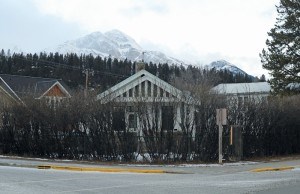
There was standing room only, as more than a dozen residents packed into the Grand Trunk Pacific Boardroom, Dec. 18, to oppose the rezoning of two lots on Connaught Drive for the development of an apartment building.
Rob Olson, who owns the lots adjacent to the Crimson Jasper, received conditional approval for the zoning change in October, but after an outpouring of opposition letters and some procedural issues, the Planning and Development Advisory Committee (PDAC) decided to hold a second hearing, where it heard six oral presentations and read aloud four letters—two in support and two in opposition.
Olson is requesting that the zoning of 120 and 122 Connaught Dr. be changed from R2 (two-unit dwelling) to R3b (multi-unit dwelling) so that he can develop a 10-unit apartment building.
“This is two-bedroom, two-bathroom apartments for families or people who are going to be here in the long term,” explained Olson during the hearing, noting that he doesn’t intend for the building to become staff accommodation for his restaurant, Earls in the Rockies.
But residents in the neighbourhood aren’t so keen on seeing such a building developed, citing numerous reasons for their disapproval, including the loss of views and sunlight, increasing density in an already busy neighbourhood, parking issues, the precedent of allowing spot zoning and a disinterest in having rental units next door.
Six residents spoke out in opposition: John Glaves, Val Glaves, Tony Mastrianni, Brenda Zinck, Don Pickle and Kirsten Schmitten, and five others gave proxy, allowing John Glaves and Schmitten to speak on their behalf.
The presentations varied, some pointed out the problems with the PDAC process, others pointed out the incongruencies in Olson’s own presentation from the September hearing, and others still pulled apart Parks Canada’s conditional approval—pointing to statements in the Jasper Community Sustainability Plan as reasons why the request should have been rejected.
“What happened to a modest and incremental overall increase in density that compliments existing community fabric, as promised in the community sustainability plan?” asked Val Glaves, who suggested rezoning of the two lots would go against the 2011 plan, which was originally created with significant community input.
Zinck and Pickle both talked about the problem with spot zoning and Pickle argued that infilling shouldn’t overwhelm a neighbourhood. Mastrianni suggested that if the community wants to fix the housing shortage, it should develop on the lots that are already zoned for multi-unit dwellings.
Schmitten argued that an increase in density will bring with it an increase in noise and traffic and noted that with a 10-unit building, with eight two-bedroom apartments and two three-bedroom apartments, there could be up to 25 additional people calling the neighbourhood home.
“That’s more than double the density of two duplexes,” she said, referring to what could be built on the lots under their current zoning.
“Higher density brings increased noise, traffic and possibly crime and we are worried about how this could change the character and value of our properties—I’m a property owner right behind this development.”
Schmitten went on to point out that within the community sustainability plan, up-zoning can take place, but only if the lot meets a list of criteria. One of those criteria is that the rezoning must be compatible with adjacent land uses, and Schmitten argued that because the neighbourhood is zoned R2, an apartment wouldn’t fit.
“A multi-unit apartment building is not compatible with adjacent land uses in terms of massing, height, density and also the complexion of who lives in rental units and apartments.
“Duplexes are usually family units, whereas apartments tend to be renters.”
When the request for rezoning came to the advisory committee in September, there was significant opposition from the neighbourhood, similar to what was seen on Dec. 18.
There were nine letters, as well as a petition with half a dozen signatures. The arguments at the time were much the same, but despite that the committee recommended that rezoning move forward. Parks took its advice, providing conditional approval.
“Changing demographics and visitation patterns produce both challenges and opportunities that require flexibility and re-examination of what the best guidelines or zoning might be,” wrote Jeff Anderson, vice president of operations for Western and Northern Canada, in a letter to Olson. “It was felt that the impacts on the neighbourhood in terms of both density and parking would not be significantly different with either R2 or R3b development.”
As a result of that decision, the neighbourhood joined forces in an attempt to convince Parks to change its mind.
Following the second hearing, the committee will again provide a recommendation to the superintendent, who will review it and pass on his own recommendation to Anderson.
Nicole Veerman
[email protected]
